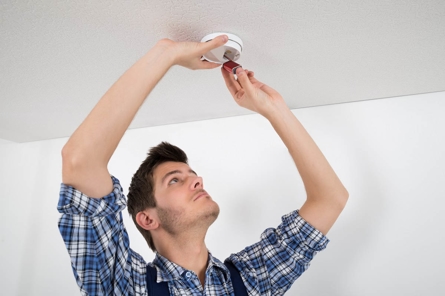
Fire prevention in the workplace is a serious matter, and not just because your livelihood is on the line. A fire can put your business at risk, but it can also do the same for the lives of you and your coworkers. Luckily, there are some basic steps you can take to ensure workplace fire safety for everyone who helps keep your business running. Check out the following seven expert tips to make sure you're doing everything you can to keep your business and coworkers safe.
Workplace Fire Safety
1. Create a fire prevention plan. Take the time to create a plan for workplace fire safety. Create guidelines for employees, make a calendar with inspection dates and important maintenance, and share it with everyone at your business.
2. Clean house. If your place of business is cluttered up with unorganized equipment, materials, debris or paperwork, you have a fire hazard on your hands. Making a clear pathway to an exit not only removes flammable items, but also helps you get to safety. Tidy up! And don't forget to keep the garbage or disposal areas clear.
3. Set a smoking policy. Smoking but it also introduces potential fire hazards. Consider the following as you create a safety-minded workplace smoking policy:
- Designate smoking and non-smoking areas.
- Have ashtrays available and make sure people use them.
- Keep ashtrays clean of other material and away from flammable items.
- Clean all ashtrays regularly.
4. Install and test smoke detectors. Smoke detectors are one of the simplest, most effective things you can do for fire prevention in the workplace. Install the best ones you can afford and inspect them regularly. Working smoke detectors can give you valuable time to react to a fire, which can make a huge difference in reducing harm to your business and the safety of your coworkers. Conduct periodic fire drills by using the test feature on your smoke alarms, to ensure that everyone knows how to react in the event of an emergency.
5. Install sprinklers. Sprinkler systems are an effective part of any workplace fire prevention plan. Used in conjunction with a warning system like smoke detectors, automatic sprinklers can help mitigate the impacts of a fire at your business. A professional can help you design a sprinkler system configuration that addresses important or at-risk areas of your business.
6. Place and check fire extinguishers. Like sprinklers, fire extinguishers can sometimes prevent a minor fire from turning into a major disaster. Buy enough fire extinguishers as appropriate for the size of your building, and make sure they'll be accessible when it matters. That means no junk or equipment making them hard to reach. Putting them under cabinets or on high shelves won't do much good when a room is full of smoke, either.
7. Check for hazards. Make time on a regular basis to inspect equipment, areas where chemicals are stored and other identified high-risk areas. Perform maintenance on electrical equipment as soon as problems are spotted. Fires are often preventable, and the last thing you want is for your business to be destroyed by a fire that could have been averted through proactive maintenance.
Smart policies, persistent vigilance and swift action can help you avoid or mitigate fire damage at your place of business. Keep your eye on the ServiceMaster Restore® blog for more tips on how to keep your workplace safe, and know that you can always contact us if a fire does hit your business. From cleaning up smoke and ash damage to evaluating damaged office equipment, our experienced crews know what it takes to help your business get back on its feet as quickly as possible.
